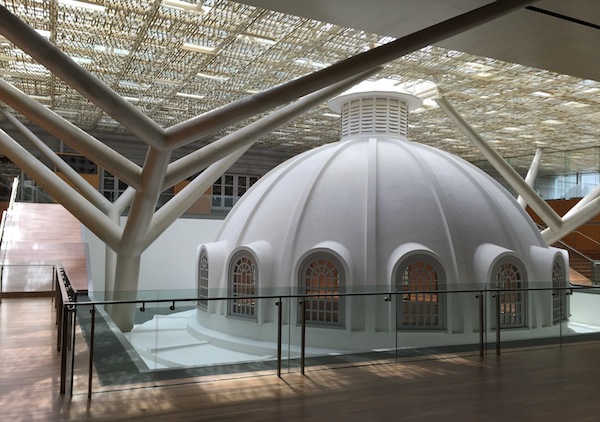Image via Pixabay
Globalisation over the past decade has resulted in a boom in new art centres, museums and biennales – particularly in Asia – and a flow assisted by cheaper travel and technology. Artists and institutions embraced the need to think globally in creative work and critical dialogue.
Global citizenship takes that a step further. Its premise is that one primarily identifies as part of an interdependent, global community rather than as a citizen of a country or member of a local community.
Museums have – by default – become platforms that promote global citizenship. But are they just following academic fashion or is there a specific role and responsibility for art as a global citizen educators? It was a topic discussed at last week’s Southeast Asian Forum hosted by Art Stage Singapore – with ambivalent outcomes.
Pros and cons
According to the UN’s Global Education First Initiative, ‘global citizenship education provides the understanding, skills, and values that students (and more broadly all communities) need to cooperate in resolving the interconnected challenges of the 21st century, including climate change, conflict, poverty, hunger, and issues of equity and sustainability.
Some might argue that art has always done that.
But traditionally, museums have shaped societies, defined identity, and created civic pride. As nations have become more hybrid and diverse, they have adjusted to remain relevant to their societies. Now with a more international culture, that adjustment is creating a convergence.
The fear is that they are heading down the path of homogenization, each with its mandatory hip café, arty shop, blockbusters, destination-designed architecture and generic logos and branding.
At worst, we are looking down the barrel of the “universal museum”, an ideological cookie cutter dropped into a different product of ‘starchitecture’ . But at best, museums and galleries can be the bridges between the universal and the local, making global citizenship meaningful to their specific audiences.
Museums with a conscience
Peggy Levitt, Co-director of the Transnational Studies Initiative at Harvard University (USA), believes that we live in a world on the move and that our museums have a responsibility to reflect that global dynamic.
‘According to the World Bank, one out of every seven people today is a migrant, whether internal or international, voluntary or involuntary…How then do we create different kinds of institutions that reflect that reality?’
She continued: ‘That is where museums come in because museums have always been about creating national citizens, so in today’s world, they creating global citizens too.’
From an education and programming standpoint museums and galleries have been gravitating towards the promotion of understanding and a more democratic engagement with audiences for some decades.
“Access” has become a key part of the rhetoric.
With it, there has been a responsibility to think more broadly of their role. Could this be the seedings of a new generation of museums that have a greater global consciousness, lead by the artists themselves and their work? 
The National Gallery of Singapore opened in November 2015 with an agenda to actively define Singapore from a national, regional and global position; Photo Gina Fairley for ArtsHub.
Nation-building
In a global world with a huge pot of cultural tourism dollars, there is also a human need for a sense of place and an economic value in creating a destination that can draw cultural tourism dollars.
Museums have become increasingly valued for the role they play in branded nation building, and are strategic catalysts to economic and cultural growth.
Levitt believes that what defines museums and galleries today is where they are situated in their ‘arc of nation building’. She cites Sweden and Denmark as examples of nations that are ‘not over empire, and were not using their museums to critique and claim the world’, where Singapore and Dohar are positioning themselves as citizens of the world.
‘Singapore wants to be a global economic and cultural city – an art destination – and it needs citizens who engage with art and enjoy it, and so art is being used to fulfill its global economic goals and to create global citizens who can compete in the global world,’ she expanded.
Levitt says that how a museum is positioned in respect to the international museum world further defines it global citizenship. She described it as ‘the global museum assemblage’ – a kind of package of people and objects and technologies that are circulating the global creating standards and status quos.
‘There is a kind of transnational class of museum professionals that circulate regionally, and globally, and these people are carrying with them this way of seeing; way of displaying, of explaining, of educating and each time they travel they make the museum world more or less globalized,’ explained Levitt.
A disruptive alternative
Jean Baptiste de Beauvais, Director of External Relations at Palais de Tokyo in Paris, explained their gallery’s mission as the renegade alternative: ‘(it) provides an opportunity to rethink the role of cultural institutions in view of the permanent speeding up of our lives.’
While that has a certain tone of global citizenry to it, the Palais de Tokyo in Paris describes itself as ‘an anti-museum par excellence’. ‘
De Beauvais added: ‘We consider that the experience of art is not just about business hours. It is about people getting in touch with artists, and going away transformed.’
The Palais is open every day from noon to midnight, and last year it had over 400,000 visitors. It raises 60% of its income from the expanded museum experience – its restaurants, entertainment, cinema, and sponsorship engagement – ensuring the museum is a complete lived package.
It is a trend that another museum in Japan has taken – the Mori Art Museum – which is open from 10am to 10pm – pushing the museum into the social field.
Perhaps these art museums illustrate that true global citizenship lies in the hands of these audiences who embed culture in the every day, and not the museum makers.
Realpolitik: the Singapore challenge
While championing this future citizenry of museums, Levitt also acknowledged its flaws and weaknesses, particularly in Singapore where soft repression” remains an issue.
‘I think Singapore is a country that is really using museums as part of its nation building – they are a tool. You can recognise yourself in it, but it is also very much told to you as a story of how we “make up” Singapore, its place in the region and connection to the globe.’
‘(However) critics say you can’t talk about cosmopolitanism in this context. Cosmopolitanism is based on certain basic and universal values that include free speech, meaningful political participation and human rights,’ she warned.
So while Singapore may have got the complex architecture right – that transnational social fields of professional networks, institutions, galleries, art fairs and auction houses, marketing and display – the new Gallery’s ability to be truly a global citizen will depend partly on how it manages ideological tensions and pragmatic politics.
Global citizenship is both an aspiration and responsibility for cultural institutions but it will always be challenged by national agendas.




